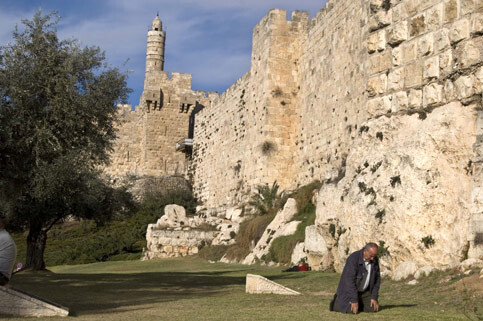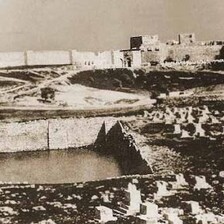The Electronic Intifada 6 November 2008

A Palestinian Muslim prays outside the Jaffa Gate of the Old City of Jerusalem. (Marko Wramen/MaanImages)
Israel seems to have little time for the irony that a modern Jewish shrine to “coexistence and tolerance” is being built on the graves of the city’s Muslim forefathers.
The Israeli high court’s approval last week of the building of a Jewish Museum of Tolerance over an ancient Muslim cemetery in Jerusalem is the latest in a series of legal and physical assaults on Islamic holy places since Israel’s founding in 1948.
The verdict ended a four-year struggle by Islamic authorities inside Israel to stop development at the Mamilla cemetery, which lies in the shadow of Jerusalem’s Old City walls, close to Jaffa Gate.
After the judgment, Jerusalem’s mufti, Sheikh Mohammed Hussein, called the museum’s building “an act of aggression” against the Muslim public.
The furore from both religious and secular Palestinians has apparently bemused most Israeli observers.
Rabbi Marvin Hier, initiator of the project, dismissed objections last week as cover for “a land grab by Islamic fundamentalists, who are in cooperation with Hamas.” His view that Muslim concerns are really an attack on the Jewish state’s sovereignty is shared by many.
Such sentiments have confirmed to most Palestinians the degree to which Israeli authorities make decisions while oblivious of Palestinian religious and national rights.
Although Muslim leaders angrily warned from the outset that the Museum of Tolerance would require the disinterring of graves, they were ignored until spring 2006, when it was reported that dozens of skeletons had been unearthed during the early excavations.
The local media also revealed at the time that state archaeologists had been secretly trying to move the skeletons without alerting the local Muslim authorities, as they should have done, and that many of the skeletons had been damaged in the process.
When several months of arbitration between the developers and Muslim leaders proved fruitless, the courts stepped in.
Ostensibly, the driving force behind the museum, which is to cost $250 million, is the Simon Wiesenthal Center, a private Los Angeles-based Jewish human rights organization. But the venture is being pushed through with equal vigor by Israeli officials from the government, Jerusalem municipality and Lands Administration.
For many years it has been their priority to obscure all indications of the Muslim presence in the western part of Jerusalem — as well as in many areas of Israel — that predate the Jewish state’s founding in 1948.
The treatment of the Mamilla cemetery, which is said to include the burial sites of the Prophet Mohammed’s companions, stands in stark contrast to another ancient cemetery, nearby on the Mount of Olives.
Since East Jerusalem was illegally occupied by Israel in the 1967 war, the Jewish cemetery on the Mount has been carefully renovated and expanded as a “heritage site.”
In contrast, the Mamilla cemetery, which lies just inside West Jerusalem and was captured by the Israeli army in the 1948 war, was immediately removed from Muslim control. Classified as refugee property, it was passed on to a new Israeli official called the custodian of absentee property.
This was far from an isolated incident. Before the creation of Israel, as much as one-tenth of all territory in the Holy Land was managed as part of an Islamic endowment known as the waqf, bequeathed by Muslims for religious and charitable purposes.
After 1948, however, Israel seized all waqf property — in addition to private land belonging to refugees — and transferred it to the custodian.
Under pressure from the government in the 1950s, the custodian passed most of the undeveloped land, particularly farmland, on to a state-run body known as the Development Authority, which was charged with using it for the “public interest.” That usually meant using the profit from the land for the benefit of the Jewish public.
Other waqf property — mostly land on which holy places, including mosques and cemeteries, were located — was managed by special Islamic trusts established by the state.
This has provided the main defense adopted today by Israeli officials in justifying the siting of the museum. They say that an Islamic trust deconsecrated the Mamilla cemetery in 1964, thereby freeing up the land for development.
What they fail to point out, however, is that the Islamic trusts have no legitimacy among Palestinian Muslims in Israel, nearly one-fifth of the country’s total population, let alone among Palestinians in the occupied territories.
The Islamic officials on the trusts are widely seen as corrupt, appointed by the state because of their willingness to do the government’s bidding rather than because of their public standing or Islamic credentials.
They earned that reputation by rubber-stamping many land transactions of waqf property desired by the state. One of the most notorious occurred in the early 1960s when Muslim officials approved the sale of the large Abdul Nabi cemetery in today’s Tel Aviv for the building of a hotel and several Jewish housing developments.
This abuse of waqf land has provoked a simmering resentment among Israel’s Palestinian minority.
Last year Palestinians in the historic city of Jaffa, now little more than a suburb of Tel Aviv, tried to challenge the role of the Islamic trusts by petitioning the courts to turn control of waqf property over to genuine representatives of the Muslim public.
The government, however, refused to divulge what waqf property existed in Jaffa, claiming “the requested information would seriously harm Israel’s foreign relations.” This was presumed to refer to the damage that might be done to Israel’s image abroad should it be revealed to what uses the waqf property had been put.
Actual holy places have fared little better, with most now inaccessible even to Israel’s Palestinian citizens.
Some, such as the 900-year-old Hittin mosque built by Saladin in the Galilee region, have been fenced off and left to crumble. Others are used by rural Jewish communities as animal sheds. And yet more have been converted into discos, bars or nightclubs, including the Dahir al-Umar mosque — now the Dona Rosa restaurant — in the former Palestinian village of Ayn Hawd.
Similar dubious practices occurred with the Mamilla cemetery. From the 1950s, during a period of military government that imposed severe restrictions on all Palestinians living inside Israel, the graves and tombs belonging to Jerusalem’s most notable families began to decay. Part of the land was turned into a car park.
After the 1967 war, as Meron Benvenisti, a former deputy mayor of Jerusalem, has noted, the Muslim authorities lobbied to be allowed to rehabilitate and maintain the graves, but were refused permission.
Instead, in 1992 the custodian transferred the site to the Jerusalem municipality, which used the land to establish an Independence Park, named for Israel’s victory in the 1948 War. Then a few years later the municipality transferred a parcel of the land to the Wiesenthal Center for its Museum of Tolerance.
As Benvenisti points out, over the years many Islamic sites in Jerusalem have been “turned into garbage dumps, parking lots, roads and construction sites.”
What makes the latest fight over the Mamilla cemetery different is that in the past decade a new breed of Muslim leader has emerged in Israel to overshadow the Islamic trusts. In particular the struggle over the fate of the holy places has been taken up by the leader of the Islamic Movement inside Israel, Sheikh Raed Salah.
Last week he warned: “We will mobilize in the Arab and Muslim world so that it puts pressure to halt the project.”
Tolerance, after all, has its limits.
Jonathan Cook is a writer and journalist based in Nazareth, Israel. His latest books are Israel and the Clash of Civilisations: Iraq, Iran and the Plan to Remake the Middle East (Pluto Press) and Disappearing Palestine: Israel’s Experiments in Human Despair (Zed Books). His website is www.jkcook.net.
This article originally appeared in The National published in Abu Dhabi and is republished with permission.




